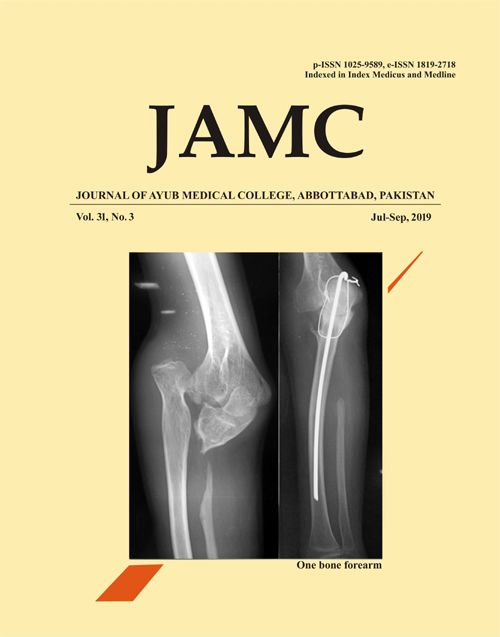EFFICACY OF MICRO-NEEDLING ON POST ACNE SCARS
Abstract
Background: Acne effects 80–90% of teenage population all around the world. Resulting scars can lead to facial disfigurement and psychological issues in affected population. To counter this problem many treatment options have been tried including resurfacing lasers, dermabrasion, peeling, fillers, platelet rich plasma therapy etc. All have shown variable results. Among these modalities, micro needling is showing promising results in treatment of acne scars due to collagen induction. This study was conducted to assess efficacy and safety of micro-needling on acne scars. Methods: In this cross-sectional study a total of 50 patients (female 35, male 15) underwent treatment for post acne scarring, 4 sessions of micro-needling were done under local anaesthesia 3 weeks apart over the span of 2 months. Initial and follow up qualitative assessment was done. Photographs were taken of each patient on their subsequent visit, they were analysed and compared for final results. Grading was done by using Goodman Baron scale. Results: 70% (35) were females and 30% (15) were males with mean age of 27.31±4.41 ranging from 19–35 years. After the treatment of scars, 73% (08) of Grade 4 scars have showed improvement by 2 grades, remaining 27% (03) showed improvement to Grade 3. In 20 patients with Grade 3 scars, 30% (06) showed improvement by 1 grade. Remaining 70% (14) improved by 2 grades. All patients with Grade 2 scar downgraded to grade 1 after treatment. Chi-square test was used to assess pre-treatment and post treatment grading improvement among subjects and was statistically significant. (X2=30.010 p=000). Conclusion: Micro needling is an effective tool for aesthetic improvement of post acne scarring.Keywords: Acne; Acne scarring; Micro-needling Acne; Acne scarring; Micro-needlingReferences
Kranning KK, Odland GF. Prevalence, morbidity and cost of dermatological diseases. J Invest Dermatol 1979;73(5 Pt 2):395–401.
Yeung CK, Teo LHY, Xiang LH, Chan HHL. A community-based epidemiological study of acne vulgaris in Hong Kong adolescents. Acta Derm Venereol 2002;82(2):104–7.
Kanjee A, Sohail A, Sami A. Topical isotretinoin in the treatment of Acne Vulgaris: A clinical trial. J Pak Assoc Derma 1999;9:20–3.
Asad F, Qadir A, Ahmed L. Anxiety and Depression in patients with acne vulgaris. J Pak Assoc Derma 2002;12(2):69–72.
Fabbrocini G, Fardella N, Monfrecola A, Proietti I, Innocenzi D. Acne scarring treatment using skin needling. Clin Exp Dermatol 2009;34(8):874–9.
Fife D. Practical evaluation and management of atrophic acne scars: tips for the general dermatologist. J Clin Aesthet Dermatol 2011;4(8):50–7.
Cotterill JA, Cunliffe WJ. Suicide in dermatologic patients. Br J Dermatol 1997;137(2):246–50.
Koo JY, Smith LL. Psychologic aspects of acne. Pediatr Dermatol 1991;8(3):185–8.
Koo J. The psychosocial impact of acne: patients’ perceptions. J Am Acad Dermatol 1995;32(5 Pt 3):S26–30.
Rivera AE. Acne scarring: A review and current treatment modalities. J Am Accad Dermatol 2008;59(4):659–76.
Jacob CI, Dover JS, Kaminer MS. Acne scarring: A classification system and review of treatment options. J Am Acad Dermatol 2001;45(1):109–17.
Fabbrocini G, Annunziata MC, D'Arco V, Vita DV, Lodi G, Mauriello MC, et al. Acne Scars: Pathogenesis, Classification and Treatment. Dermatol Res Pract 2010;2010:893080.
Orentreich DS, Orentreich N. Subcutaneous incisionless (subcision) surgery for the correction of depressed scars and wrinkles. Dermatol Surg 1995;21(6):543–9.
Fernandes D. Minimally invasive percutaneous collagen induction. Oral Maxillofac Surg Clin North Am 2005;17(1):51–63.
Camirand A, Doucet J. Needle dermabrasion. Aesthetic Plast Surg 1997;21(1):48–51.
Cohen IK, Die-gelmann RF, Lindblad WJ, Hugo NE. Wound healing: biochemical and clinical aspects. Plast Reconstr Surg 1992;90(5):926.
Liebl H. Abstract reflections about collagen induction therapy (CIT). A hypothesis for the mechanism of action of collagen induction therapy (CIT) using micro-needles. [Internet]. [cited 2008 30 Oct]. Available from: http://www.dermaroller.de/us/science/abstract-reflections-26.html
Jaffe LF. Control of development by steady ionic currents. Fed Proc 1981;40(2):125–7.
Fernandes D, Signorini M. Combating photoaging with percutaneous collagen induction. Clin Dermatol 2008;26(2):192–9.
Aust MC, Fernandes D, Kolokythas P, Kaplan HM, Voqt PM. Percutaneous collagen induction therapy. An alternative treatment for scars, wrinkles, and skin laxity. Plast Reconstr Surg 2008;121(4):1421–9.
Published
Issue
Section
License
Journal of Ayub Medical College, Abbottabad is an OPEN ACCESS JOURNAL which means that all content is FREELY available without charge to all users whether registered with the journal or not. The work published by J Ayub Med Coll Abbottabad is licensed and distributed under the creative commons License CC BY ND Attribution-NoDerivs. Material printed in this journal is OPEN to access, and are FREE for use in academic and research work with proper citation. J Ayub Med Coll Abbottabad accepts only original material for publication with the understanding that except for abstracts, no part of the data has been published or will be submitted for publication elsewhere before appearing in J Ayub Med Coll Abbottabad. The Editorial Board of J Ayub Med Coll Abbottabad makes every effort to ensure the accuracy and authenticity of material printed in J Ayub Med Coll Abbottabad. However, conclusions and statements expressed are views of the authors and do not reflect the opinion/policy of J Ayub Med Coll Abbottabad or the Editorial Board.
USERS are allowed to read, download, copy, distribute, print, search, or link to the full texts of the articles, or use them for any other lawful purpose, without asking prior permission from the publisher or the author. This is in accordance with the BOAI definition of open access.
AUTHORS retain the rights of free downloading/unlimited e-print of full text and sharing/disseminating the article without any restriction, by any means including twitter, scholarly collaboration networks such as ResearchGate, Academia.eu, and social media sites such as Twitter, LinkedIn, Google Scholar and any other professional or academic networking site.









